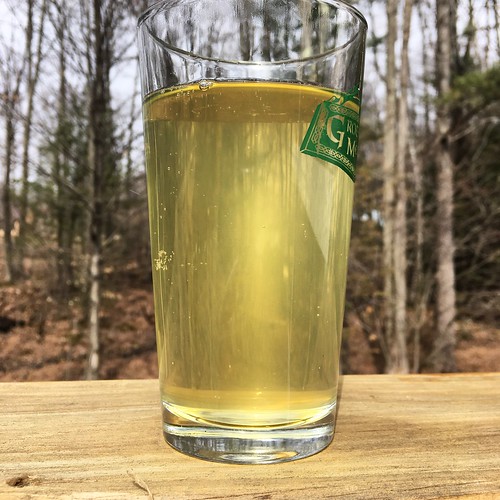Homebrew #55: Evil Clone (Mk. II)
¶ by Rob FrieselThe story behind this brew is as simple as it gets. I made a clone of Havoc’s Root of All Evil; it was a huge hit here at home, and we were running low. The obvious solution? Make some more of Evil Clone (Mk. II):
Brew Day
Is it even worth re-hashing a casual mead-making day? Collecting the equipment and ingredients; heating the water; mixing the honey to make the must; adding the Campden tablets and waiting for them to do their sciencey magic…
“It’s just mead making.”
Fermentation
After the Campden tablets killed off any extant microflora, I rehydrated the yeast (EC-1118) and pitched along with 4.5 g of Fermaid-K and 4 g DAP. Following the staggered nutrient addition protocol, I added those same amounts of Fermaid-K and DAP after 2, 4, and 6 days.
As this was the ginger mead we were making here, I went to add the ginger (fresh, grated, 12 oz.) and lime juice (fresh squeezed, from 5 limes) after 4 days. Unfortunately, I dramatically over-estimated my available headspace.
Consequently, I had to do an emergency transfer and rack to a larger fermentation vessel. Whoops. At least that was an option here. Safely transferred, fermentation continued.
Two weeks after pitching, I took my first gravity reading: 0.998. Which is where it locked in as the final gravity. Four days later, it was still sitting at 0.998.
When I packaged, I primed with corn sugar. I filled 45 × 12 oz. bottles — but also managed to have some losses and transferred sediment from the free-floating ginger. (Why don’t I remember that from last time?)
And so… I let it bottle condition for that carbonation.
Overall Impressions
I like it, but it’s not as good as the first batch I made. Not as spicy, and more vinous.
AROMA. Prominent and assertive ginger. Mild honey; lightly floral behind. No discernible fermentation characteristics.
APPEARANCE. Bottles are uneven; most are very clear, though some are a little hazy. Pale yellow. Lots of fine fast-rising bubbles.
FLAVOR. Moderate-to-assertive ginger spice throughout. Honey aspect is mild to moderate. Dry, with very low residual sweetness. Lightly floral retronasal character. Fermentation profile evokes a white wine, and finishes very soft (though the ginger spice complicates that).
MOUTHFEEL. Light body. On the higher side of medium carbonation. Very dry. Some lingering “zing” from the carbonation and spicy ginger character.
OVERALL IMPRESSION. Reads like a sparkling wine with a dominant ginger impression, though ginger is on the high side of moderate and not aggressive. The bone dry finish leaves little of the source honey’s character behind.
Between this mead and the Kirkland Clover Challenge, one thing has become clear: the honey matters. This should have been apparent when comparing my results between “Imposter Syndrome” and “Syntactic Sugar”; those two meads were different in ways that could not be explained by the yeast selections alone. Nevertheless, it took some more experimentation for the lesson to come all the way home.
This batch is decent, but it’s a far cry from that first batch. We’ll finish these, for sure — no doubt about that. But next time we’ll rewind the tape back to that first batch, and go from there.
Recipe
The recipe for Evil Clone (Mk. II) is as follows:
Water Chemistry
Starting with the Champlain Water District profile as a base, add 1 Campden tablet per gallon.
Fermentables
- 5 lb. clover honey
- 3 lb. wildflower honey
Flavor Agents
- 2 oz./gal. finely grated ginger root (add after 4 days)
- juice of 1 lime per gallon (add after 4 days)
Yeast
1 sachet Lalvin EC-1118
Brew Day
- Collect 19.16 qt. water and heat to 105°F. Add 2 gallons of water into mixing bucket; add honey to water and stir until dissolved.
- Transfer must into a carboy. Add 5 (crushed) Campden tablets. Swirl to mix until dissolved. Top off with water to 5 gallons.
- Let sit 24 hours for Campden tablets to work on the must.
- Aerate must; pitch EC-1118; add 0.5 g/gal Fermaid-K and 0.4 g/gal diammonium phosphate (DAP).
- Start fermentation at 64°F.
Beyond Brew Day
- For the first week, alternate de-gassing and adding nutrients. De-gas on odd days (1, 3, 5, and 7); add 0.5 g/gal Fermaid-K and 0.4 g/gal DAP on even days (2, 4, and 6).
- After approx. 4 days of fermentation add 2 oz./gal. finely grated fresh ginger. (Use a muslin bag to keep it contained.) At this time, also add the juice of 1 lime per gallon.
- Allow fermentation to complete (approx. 2-3 weeks after pitching) at approx. 64-66°F.
- After hitting final gravity, prime with corn sugar and bottle. Let condition at least 2 weeks.
- Enjoy!
Details
Evil Clone, a ginger mead by Tilde Gravitywerks
| Original Gravity | 1.063 |
| Final Gravity | 0.998 |
| ABV | 8.6% |
| Attenuation | 103.4% |
| SRM | 2 |
| Links | Flickr |
About Rob Friesel
Software engineer by day. Science fiction writer by night. Weekend homebrewer, beer educator at Black Flannel, and Certified Cicerone. Author of The PhantomJS Cookbook and a short story in Please Do Not Remove. View all posts by Rob Friesel →5 Responses to Homebrew #55: Evil Clone (Mk. II)
Pingback: 2018 Brewing Retrospective | found drama



Leave a Reply